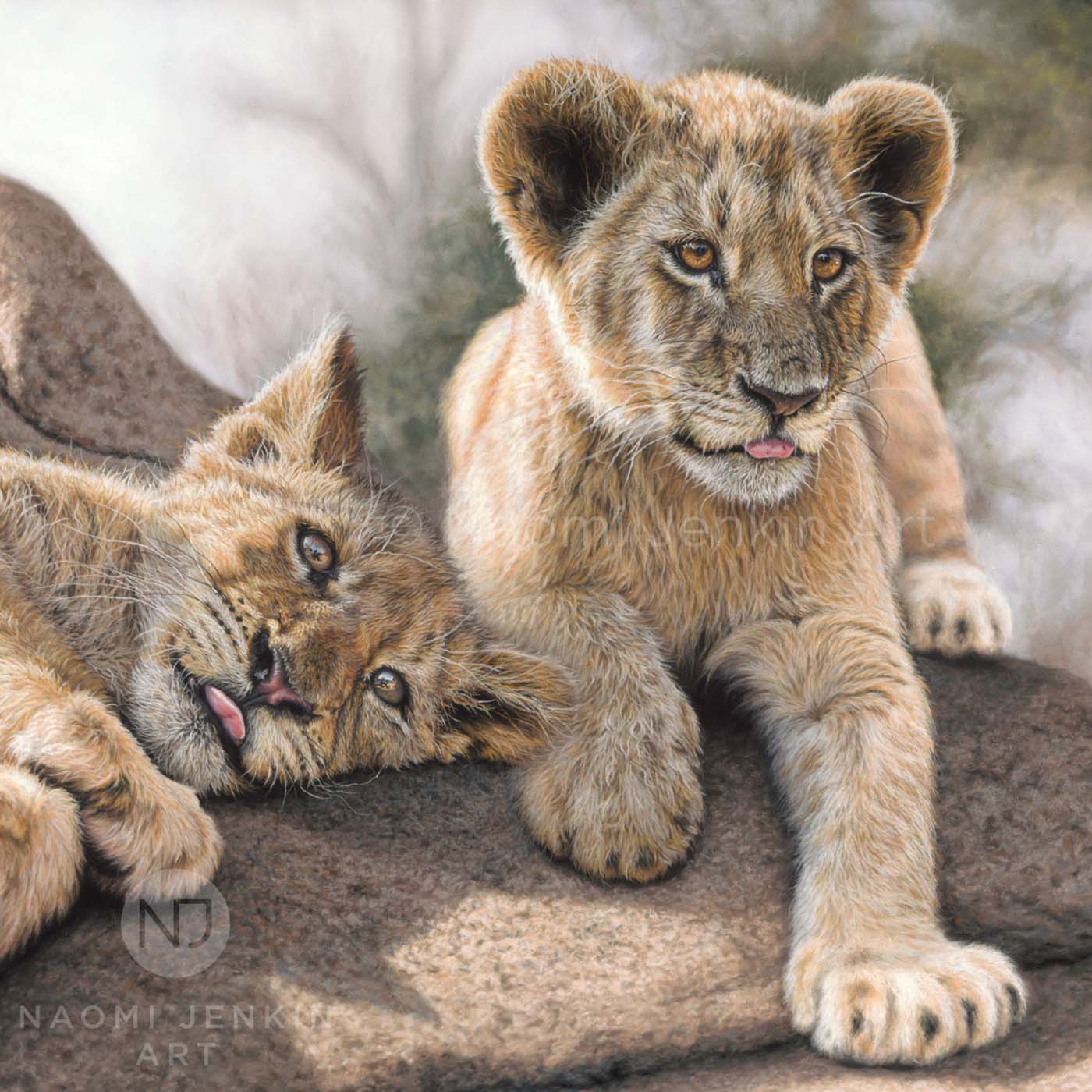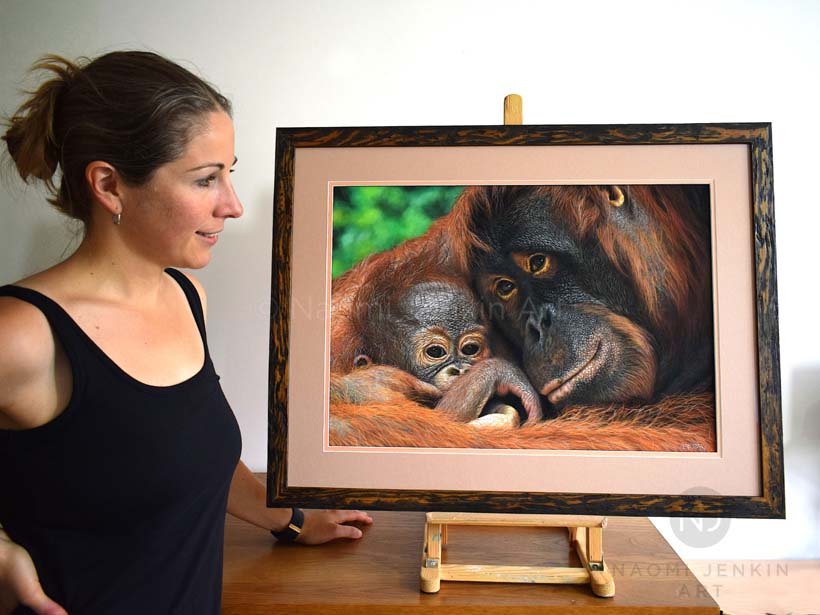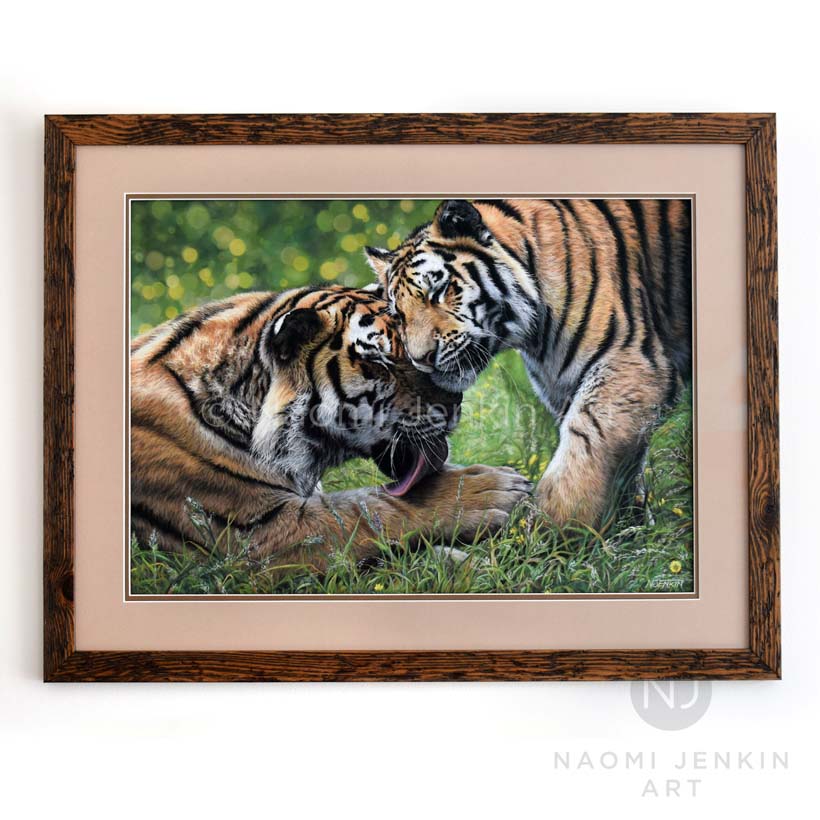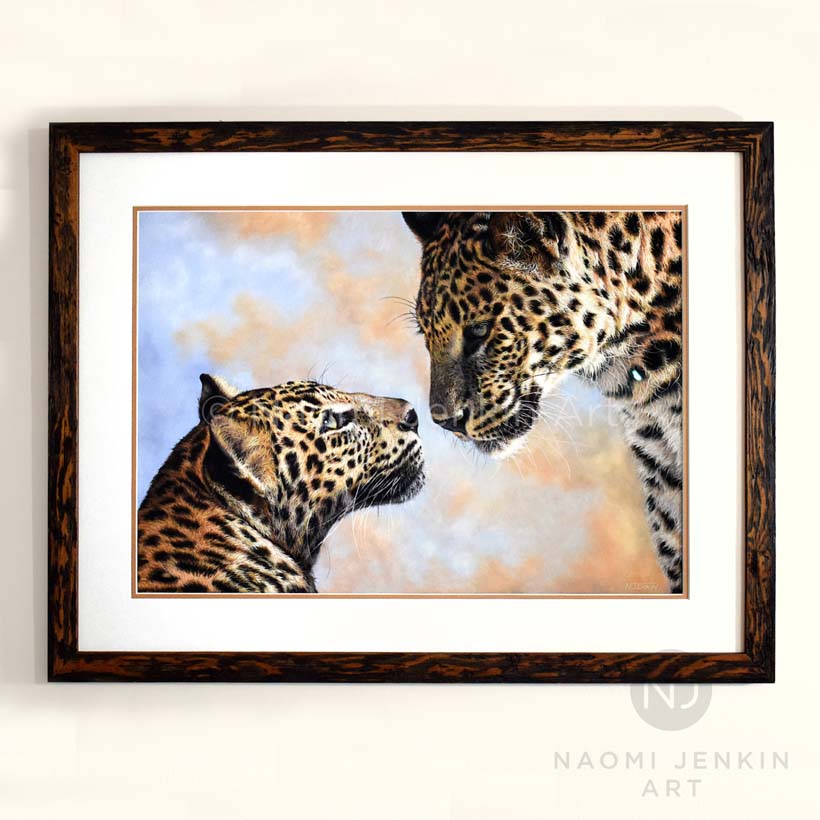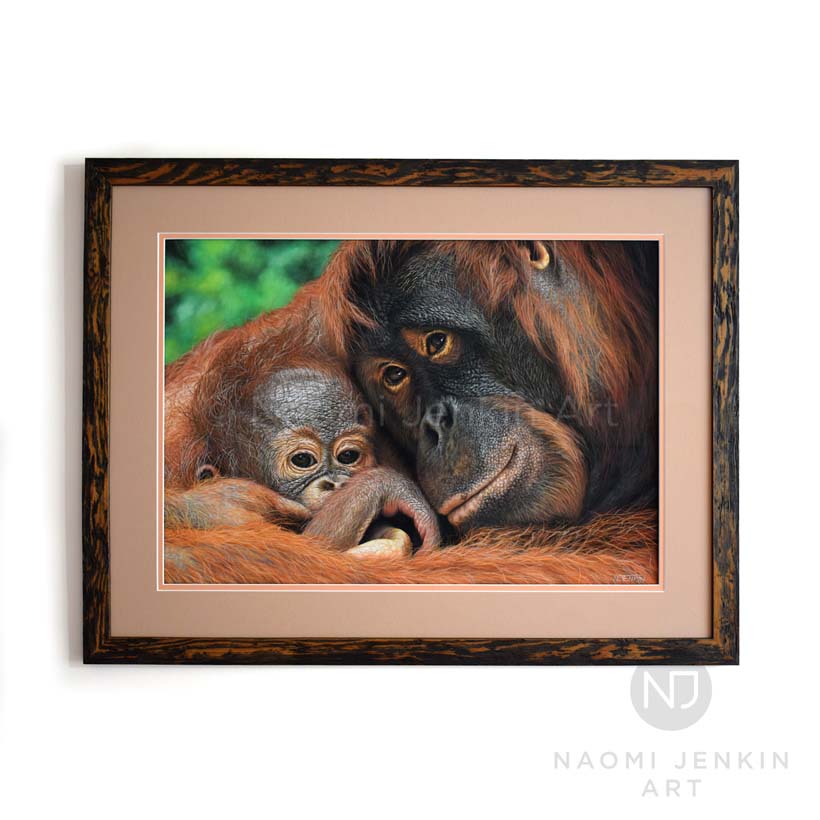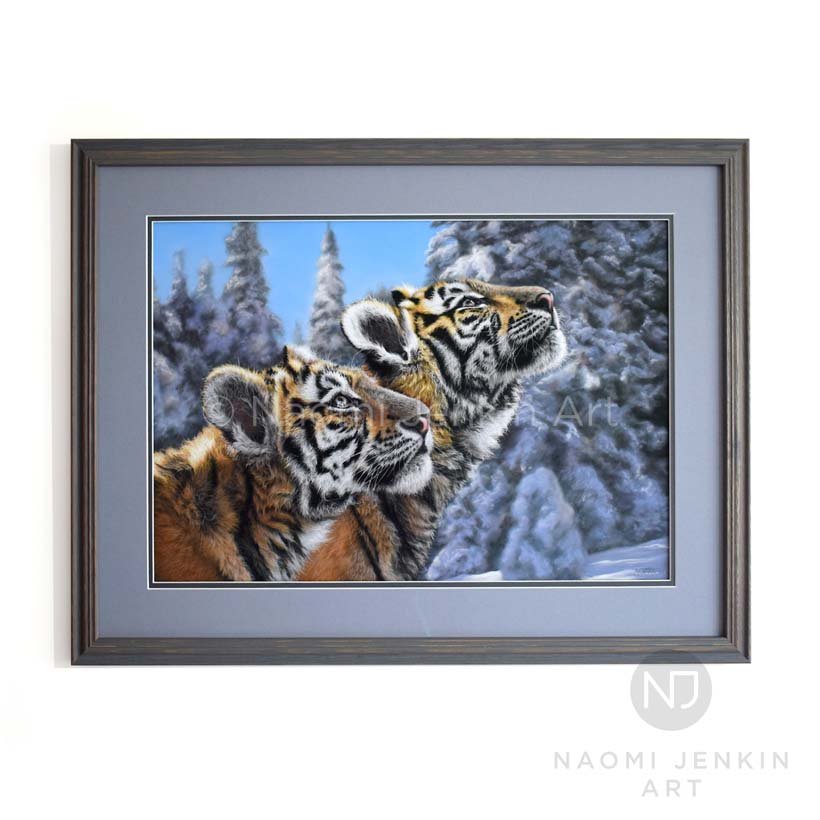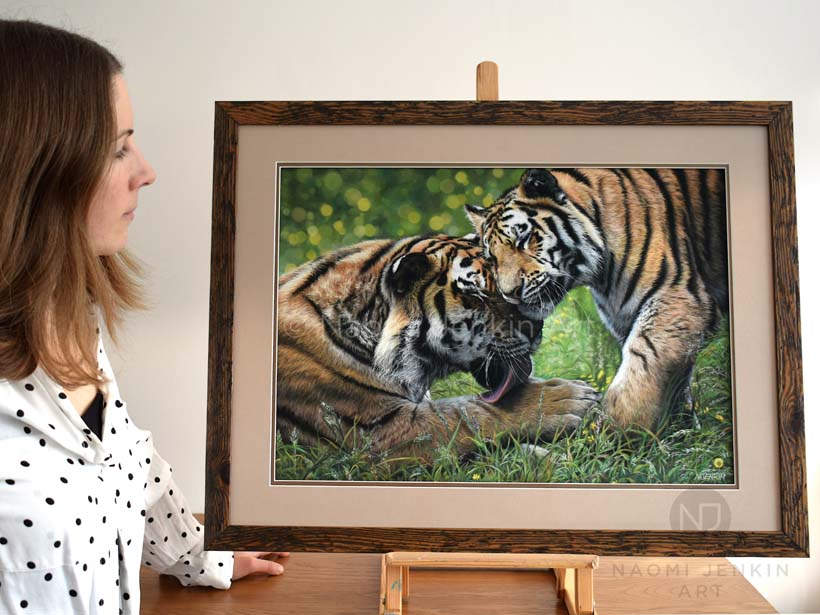
Naomi with framed tiger painting 'Devotion'
Your quick guide to framing
For a quick run down of the essential information, take a look at my video guide. Covering all aspects from your choice of moulding and mount, to what type of glass to use.
Please accept marketing-cookies to watch this video.
Framing Gallery
Professional framing service
In order to use my professional framing service, you need to be able to collect the framed artwork in person from me. This is because all my wildlife art pieces are drawn in pastels and are therefore framed behind glass. Shipping anything with glass is a risky business, as you can imagine, so I don’t chance it! I live in the UK, near Newquay in Cornwall, so if you’re located nearby, or are perhaps coming down for a holiday at some point, then my framing service will be ideal for you.
For many years I’ve worked with top local framer, Dom Turner from Studio 4 Picture Framing. He’s framed a huge variety of my works, from pet portraits, seascape oil paintings, and of course wildlife paintings. His workmanship is top notch, and I’m continually impressed by the care he puts into his work.
One of the challenges when framing your artwork, is choosing the right frame and mount to best compliment the piece. There are so many different styles and colours to choose from. Dom has a great eye for selecting the perfect combinations which really present your artwork at its best.
Your Framing Options
Choice of glass
All my wildlife pieces are drawn in pastels and so need to be framed behind glass. There are a few choices when it comes to glass. The higher spec options come at a price, but do offer some key benefits which I’ve detailed below.
Standard Glass
This is the most commonly used glass in picture framing. It’s perfectly fine, but does have some limitations. Firstly, it is highly reflective and so your artwork can often be obscured by light reflections from the room. Secondly, it offers very little in the way of UV protection.
One of the major benefits though is cost. It’s the cheapest of the glass options, so if budget is a big concern, then this will likely be the best choice for you.
UltraVue® UV70 Glass
This is a relatively new product and having seen it first hand and used it on many of my artworks, I have to say I’m seriously impressed with it. It’s become my glass of choice! I often found it frustrating how much light standard glass reflected, obscuring the details of the artwork behind. It’s likely you’ll be hanging your artwork in a well-lit room, to show it off at its best. But if all you can see are window reflections, it’s a bit annoying!
UltraVue® glass solves this problem. It has a special anti-reflective coating on the glass which diffuses light reflections. The result is a glass which is so clear, it almost looks like the glass is not there at all! For highly detailed pieces such as my wildlife art, this makes such a huge difference. Suddenly you can see all those little intricate details and really appreciate your drawing to its fullest.
In addition, it also filters up to 70% of UV rays giving that extra bit of protection for your art.
UltraVue® is more expensive than standard glass, but in my honest opinion it’s absolutely worth the investment, and I always recommend it to my clients.
Museum Glass
Museum is glass is the crème de la crème of glass! As with UltraVue®, it virtually eliminates light reflections, but additionally it blocks up to 99% of UV rays. If your artwork is going to be hung somewhere where it’s subjected to direct sunlight, then this is the glass for you. It will ensure that your art has the best protection from UV rays which would otherwise likely cause your art to fade over time.
The only downside is the price tag – it’s the most expensive of the three glass options. But it will give you peace of mind if you’re worried about the amount of direct light shining on your artwork.
Choice of Frame
This really all comes down to your own personal choice and style preferences. You might prefer traditional over more modern styles, or like something quite minimalist. If this is the case, then just let me know and I’ll work with the framer to choose something fitting for your tastes.
If you don’t have a particular preference then that’s absolutely fine. Myself and Dom will choose a frame that works really nicely with your art and ties in with the colours in the drawing. Quite often I find that my wildlife paintings work really well with natural wood frames where you can see the wood grain. The natural look of them ties in so nicely with the scenes depicted in my wildlife art. My framer has a lovely selection of natural wood frames with varying shades, from very dark to very light, and everything in between. Plus, some which have colour tints such a grey-blue which can work well for drawings which have a colder colour palette.
Choice of Mount
The mount is the card border which surrounds your artwork inside the frame. These come in a range of different colours. The choice of mount and frame go hand in hand as the colours of both need to work together to create a nice coherent border for your art.
I usually recommend going for a double mount. This means that you have two mounts, one laid on top of the other. The bottom mount has a slightly smaller aperture than the top mount which creates a slim inner border around your art. The colour of the bottom mount can be chosen to pick out one of the colours in the artwork and give a nice accent to the overall framed piece.
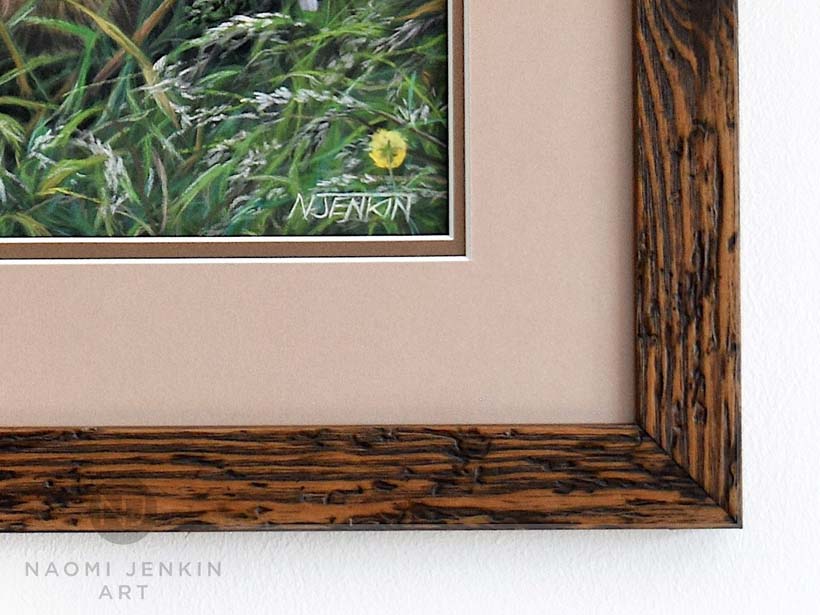 An example of a double mount, with a lovely wood grain frame.
An example of a double mount, with a lovely wood grain frame.
Timescale
Framing usually takes around two weeks but can vary slightly according the framers work load. I’ll always advise you of a timeframe though, and will keep you informed when your art is ready for collection. Always let me know if you need it for a specific date, and I’ll do my best to accommodate.
Price guide
The prices below are a rough guide only, as different frames and mounts cost slightly different prices, and the cost of materials fluctuates over time. However, these will give you a ball park figure. I’ll always give you a bespoke framing quote after discussing your preferences with you and speaking with my framer.
A4 artwork
Standard glass - £70
UltraVue® glass - £100
A3 artwork
Standard glass - £100
UltraVue® glass - £150
A2 artwork
Standard glass - £145
UltraVue® glass - £220
For museum glass prices, please contact me directly.
How to book your framing
To take advantage of my professional framing service, simply get in touch with me. Whether you’ve booked in a wildlife commission with me, or purchased a wildlife drawing from my online shop, we can discuss your requirements, and I can get you a bespoke quote and timeframe estimation.
Using your own framer?
If you’re not able to use my framing service, don’t worry. I always provide a framing advice flyer with all my artworks. This will give you some helpful information about your artwork for both you and your framer.
Plus, you can read my Framing Guide which is designed to help you in getting your artwork framed yourself, and advises you on how to make the best choices.

